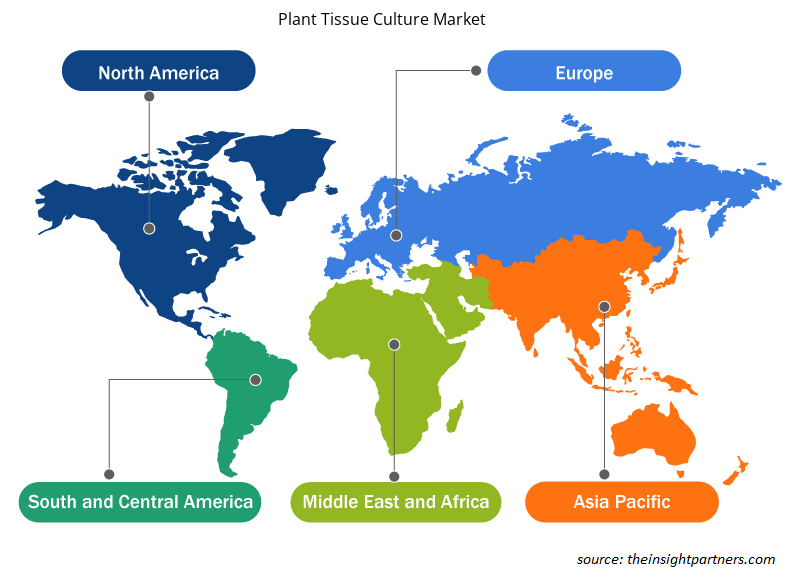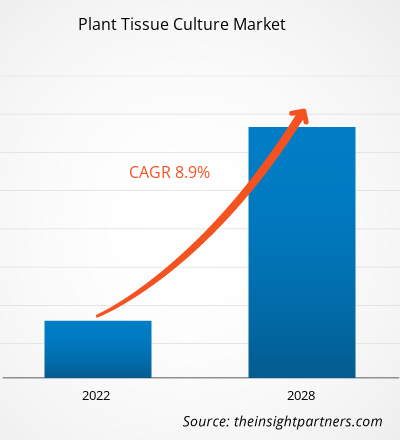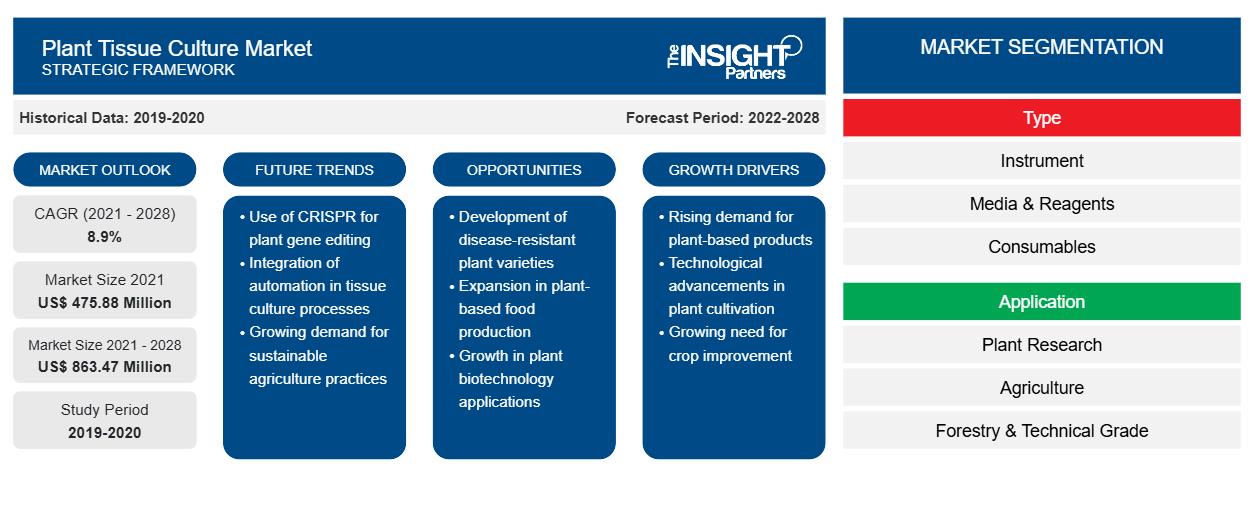[Forschungsbericht] Der Markt für Pflanzengewebekulturen wurde im Jahr 2021 auf 475,88 Millionen US-Dollar geschätzt; es wird erwartet, dass er von 2022 bis 2028 mit einer durchschnittlichen jährlichen Wachstumsrate von 8,9 % wächst.CAGR of 8.9% from 2022 to 2028.
Die Pflanzengewebekultur ist eine Reihe von Techniken, die zum Züchten von Pflanzenzellen, -geweben oder -organen unter In-vitro-Bedingungen auf einem Kulturmedium bekannter Zusammensetzung verwendet werden. Pflanzenklone können durch Mikrovermehrung erzeugt werden. Die Gewebekultur ermöglicht die Produktion von krankheitsfreiem, hochwertigem Pflanzenmaterial. Sie erleichtert auch das schnelle und gleichmäßige Wachstum von Pflanzen. Die steigende Nachfrage nach gentechnisch veränderten Pflanzen und die Verbreitung der Blumenzucht sind die Schlüsselfaktoren, die das Marktwachstum vorantreiben. Die hohen Kosten der Gewebekulturverfahren behindern jedoch den Marktfortschritt.
Der Markt für Pflanzengewebekulturen wird auf der Grundlage von Technologie, Anwendung, Material und Geografie analysiert. Der Bericht bietet Einblicke und eine eingehende Analyse des Marktes für Pflanzengewebekulturen und legt dabei den Schwerpunkt auf verschiedene Parameter wie Markttrends, technologische Fortschritte und Marktdynamik sowie die Analyse der Wettbewerbslandschaft führender Marktteilnehmer.
Passen Sie diesen Bericht Ihren Anforderungen an
Sie erhalten kostenlose Anpassungen an jedem Bericht, einschließlich Teilen dieses Berichts oder einer Analyse auf Länderebene, eines Excel-Datenpakets sowie tolle Angebote und Rabatte für Start-ups und Universitäten.
-
Holen Sie sich die wichtigsten Markttrends aus diesem Bericht.Dieses KOSTENLOSE Beispiel umfasst eine Datenanalyse von Markttrends bis hin zu Schätzungen und Prognosen.
Markteinblicke
Steigende Nachfrage nach gentechnisch veränderten Pflanzen fördert Wachstum im Markt für Pflanzengewebekulturen
Transgene Pflanzen sind Pflanzen, deren DNA mithilfe gentechnischer Verfahren verändert wurde, um der Pflanze eine neue Eigenschaft zu verleihen, die in der Natur nicht vorkommt. Diese gentechnisch veränderten Pflanzen werden mithilfe gentechnischer Verfahren im Labor erzeugt, indem die genetische Zusammensetzung verändert wird, normalerweise durch Hinzufügen eines oder mehrerer Gene zum Genom einer Pflanze. Transgene Pflanzen werden hauptsächlich entwickelt, um die notwendigen Nährstoffe bereitzustellen und den weltweiten Nahrungsmittelbedarf zu decken.
Millionen von Menschen leiden an Unterernährung, die in Entwicklungs- und unterentwickelten Ländern noch häufiger vorkommt. Laut Weltgesundheitsorganisation (WHO) waren im Jahr 2019 etwa 462 Millionen Menschen untergewichtig. Laut UNICEF ist fast die Hälfte aller Todesfälle bei Kindern unter fünf Jahren auf Unterernährung zurückzuführen. Darüber hinaus waren im Jahr 2020 etwa 45,4 Millionen Kinder unter fünf Jahren ausgezehrt, und etwa 13,6 Millionen davon waren schwer ausgezehrt. Laut Global Change Data Lab waren im Jahr 2019 8,9 % der Weltbevölkerung unterernährt. Unterernährte Menschen sind diejenigen, deren Kalorienaufnahme unter dem Mindestenergiebedarf liegt. Forscher konzentrieren sich auf die Entwicklung gentechnisch veränderter Pflanzen, die die erforderlichen Kalorien liefern, um diesen Kalorienbedarf zu decken. Die Nachfrage nach gentechnisch veränderten Pflanzen treibt das Wachstum des Marktes für Pflanzengewebekulturen an.undernutrition. Moreover, in 2020, about 45.4 million children under the age of five were wasted, and about 13.6 million out of these were severely wasted. According to Global Change Data Lab, in 2019, 8.9% of the world’s population was undernourished. Undernourished people are those who have calorie intake below minimum energy requirements. Researchers are focusing on developing transgenic plants that provide the required calories to meet these calorie requirements. The demand for transgenic plants is fueling the growth of the plant tissue culture market.
Typbasierte Erkenntnisse
Der Markt für Pflanzengewebekulturen ist nach Typ in Instrumente, Medien und Reagenzien sowie Verbrauchsmaterialien unterteilt. Das Segment Instrumente hatte 2021 den größten Marktanteil. Es wird jedoch erwartet, dass das Segment Verbrauchsmaterialien im Prognosezeitraum die höchste durchschnittliche jährliche Wachstumsrate verzeichnet. Zu den in der Pflanzengewebekultur verwendeten Instrumenten gehören Kühlschränke, Destillationsanlagen, Laminar-Air-Flow-Systeme, Waagen, Inkubatoren, Zentrifugen, Sterilisatoren usw.CAGR during the forecast period. Instruments used in plant tissue culture include refrigerators, distillation plants, laminar air flow systems, weighing balance, incubators, centrifuges, sterilizers, etc.
Anwendungsbasierte Erkenntnisse
Basierend auf der Anwendung ist der Markt für Pflanzengewebekulturen in Pflanzenforschung, Landwirtschaft, Forstwirtschaft und technische Qualität und andere unterteilt. Das Segment Landwirtschaft hatte 2021 den größten Marktanteil. Es wird jedoch erwartet, dass das Segment Pflanzenforschung zwischen 2022 und 2028 die höchste durchschnittliche jährliche Wachstumsrate verzeichnet.CAGR during 2022–2028.
Endbenutzerbasierte Erkenntnisse
Basierend auf dem Endverbraucher ist der Markt für Pflanzengewebekulturen in Gewächshäuser, Felder und Labore unterteilt. Das Feldsegment hatte 2021 den größten Marktanteil. Darüber hinaus wird erwartet, dass der Markt für dieses Segment im Zeitraum 2022–2028 mit einer durchschnittlichen jährlichen Wachstumsrate von 9,2 % wächst.
In vielen Ländern hat COVID-19 die grenzüberschreitende Mobilität der Menschen eingeschränkt und Lockdowns haben zu einem Arbeitskräftemangel in der Landwirtschaft beigetragen, insbesondere in jenen Sektoren, die durch saisonale Spitzenzeiten der Arbeitskräftenachfrage oder arbeitsintensive Produktion gekennzeichnet sind. So haben beispielsweise Reiseverbote innerhalb der Europäischen Union sowie die Schließung des Schengen-Raums in vielen europäischen Ländern die verfügbare Belegschaft im Obst- und Gemüsesektor stark reduziert. Der Mangel an Arbeitskräften hat zu Produktionsausfällen und Engpässen auf dem Markt geführt. Der COVID-19-Notstand hat die Logistik, den Vertrieb und die Lieferketten von Gartenbauprodukten beeinträchtigt. Dies hat aufgrund von Unterbrechungen in der Lieferkette für Agrarprodukte zu Ernährungsunsicherheit geführt und in der Folge hatten große Teile der Bevölkerung Schwierigkeiten, an frische Lebensmittel zu vernünftigen Preisen zu kommen. Die oben genannten Faktoren hatten schwerwiegende Auswirkungen auf die gesamte Pflanzengewebekulturindustrie.
Regionale Einblicke in den Markt für Pflanzengewebekulturen
Die regionalen Trends und Faktoren, die den Markt für Pflanzengewebekulturen im Prognosezeitraum beeinflussen, wurden von den Analysten von Insight Partners ausführlich erläutert. In diesem Abschnitt werden auch die Marktsegmente und die Geografie für Pflanzengewebekulturen in Nordamerika, Europa, im asiatisch-pazifischen Raum, im Nahen Osten und Afrika sowie in Süd- und Mittelamerika erörtert.

- Erhalten Sie regionale Daten zum Markt für Pflanzengewebekulturen
Umfang des Marktberichts über Pflanzengewebekulturen
| Berichtsattribut | Details |
|---|---|
| Marktgröße im Jahr 2021 | 475,88 Millionen US-Dollar |
| Marktgröße bis 2028 | 863,47 Millionen US-Dollar |
| Globale CAGR (2021 - 2028) | 8,9 % |
| Historische Daten | 2019-2020 |
| Prognosezeitraum | 2022–2028 |
| Abgedeckte Segmente |
Nach Typ
|
| Abgedeckte Regionen und Länder |
Nordamerika
|
| Marktführer und wichtige Unternehmensprofile |
|
Dichte der Marktteilnehmer für Pflanzengewebekulturen: Auswirkungen auf die Geschäftsdynamik verstehen
Der Markt für Pflanzengewebekulturen wächst rasant, angetrieben durch die steigende Nachfrage der Endnutzer aufgrund von Faktoren wie sich entwickelnden Verbraucherpräferenzen, technologischen Fortschritten und einem größeren Bewusstsein für die Vorteile des Produkts. Mit steigender Nachfrage erweitern Unternehmen ihr Angebot, entwickeln Innovationen, um die Bedürfnisse der Verbraucher zu erfüllen, und nutzen neue Trends, was das Marktwachstum weiter ankurbelt.
Die Marktteilnehmerdichte bezieht sich auf die Verteilung der Firmen oder Unternehmen, die in einem bestimmten Markt oder einer bestimmten Branche tätig sind. Sie gibt an, wie viele Wettbewerber (Marktteilnehmer) in einem bestimmten Marktraum im Verhältnis zu seiner Größe oder seinem gesamten Marktwert präsent sind.
Die wichtigsten auf dem Markt für Pflanzengewebekulturen tätigen Unternehmen sind:
- Segra International Corp
- JRT Nurseries Inc
- Thomas Scientific LLC
- Sigma-Aldrich Co LLC
- HiMedia Laboratories Pvt Ltd
Haftungsausschluss : Die oben aufgeführten Unternehmen sind nicht in einer bestimmten Reihenfolge aufgeführt.

- Überblick über die wichtigsten Akteure auf dem Markt für Pflanzengewebekulturen
Im Jahr 2022 hatte Nordamerika den größten Anteil am Markt für Pflanzengewebekulturen. Das Marktwachstum in dieser Region ist auf einen Anstieg der Forschungs- und Entwicklungsaktivitäten im Bereich der Gewebekultur zurückzuführen. Darüber hinaus wird erwartet, dass der asiatisch-pazifische Raum im Prognosezeitraum die schnellste CAGR verzeichnet. China, Japan und Indien sind die Hauptbeitragszahler zum Markt für Pflanzengewebekulturen in dieser Region. Das Marktwachstum in der APAC-Region ist auf zunehmende staatliche Investitionen in die Förderung der gewebekulturbasierten Forschung, den zunehmenden Einsatz fortschrittlicher Technologien und Verbesserungen der Infrastruktur zur Unterstützung der Gewebekulturlabore zurückzuführen.
Geografisch ist der Markt für Pflanzengewebekulturen in Nordamerika (USA, Kanada und Mexiko), Europa (Großbritannien, Deutschland, Frankreich, Italien, Spanien und übriges Europa), Asien-Pazifik (China, Japan, Indien, Südkorea, Australien, übriger Asien-Pazifik-Raum), Naher Osten und Afrika (VAE, Saudi-Arabien, Afrika und übriger Naher Osten und Afrika) sowie Süd- und Mittelamerika (Brasilien, Argentinien und übriges Süd- und Mittelamerika) unterteilt.
Firmenprofile
- Segra International Corp
- JRT Nurseries Inc
- Thomas Scientific LLC
- Sigma-Aldrich Co LLC
- HiMedia Laboratories Pvt Ltd
- Caisson Labs Inc
- Alpha Laboratories Ltd
- Becton Dickinson und Co
- AL-Rajhi Gewebekulturlabor
- Al Wathba Marionnet LLC
- Historische Analyse (2 Jahre), Basisjahr, Prognose (7 Jahre) mit CAGR
- PEST- und SWOT-Analyse
- Marktgröße Wert/Volumen – Global, Regional, Land
- Branchen- und Wettbewerbslandschaft
- Excel-Datensatz
Aktuelle Berichte
Erfahrungsberichte
Grund zum Kauf
- Fundierte Entscheidungsfindung
- Marktdynamik verstehen
- Wettbewerbsanalyse
- Kundeneinblicke
- Marktprognosen
- Risikominimierung
- Strategische Planung
- Investitionsbegründung
- Identifizierung neuer Märkte
- Verbesserung von Marketingstrategien
- Steigerung der Betriebseffizienz
- Anpassung an regulatorische Trends























 Kostenlose Probe anfordern für - Markt für Pflanzengewebekulturen
Kostenlose Probe anfordern für - Markt für Pflanzengewebekulturen